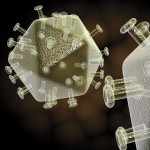A newly discovered antibiotic has proven highly effective against drug-resistant pathogens in animal studies and cell cultures, The Wall Street Journal reports. It also appears much less likely that bacteria will develop resistance to the new antibiotic than to traditional ones. Publishing their findings in the journal Nature, researchers screened some 10,000 strains of bacterial in soil to find the antibiotic they are calling teixobactin.
Teixobactin effectively combatted methicillin-resistance Staphylococcus aureus, or MRSA, in mice. The potentially fatal infection has become a major cause for concern—particularly in hospitals, as well as for people with compromised immune systems.
The antibiotic also combatted various other pathogens in cell cultures.
Researchers are hopeful that teixobactin has a strong buffer against drug resistance, because it operates by binding to fatty lipids that make up the cell wall of bacteria. Bacteria cannot easily mutate to change the nature of these building blocks so as to evade such an attack. Most antibiotics work by targeting proteins, the shape of which can shift when bacteria mutate, ultimately allowing the bacteria to evade the drug’s clutches.
There were no toxic side effects to the new antibiotic in the mice, but it remains to be seen how it will react in humans. Further animal studies will be conducted before any human trials begin.
To read the Wall Street Journal report, click here.
To read the Nature report, click here.
Advertisement
Advertisement
Advertisement






Comments
Comments